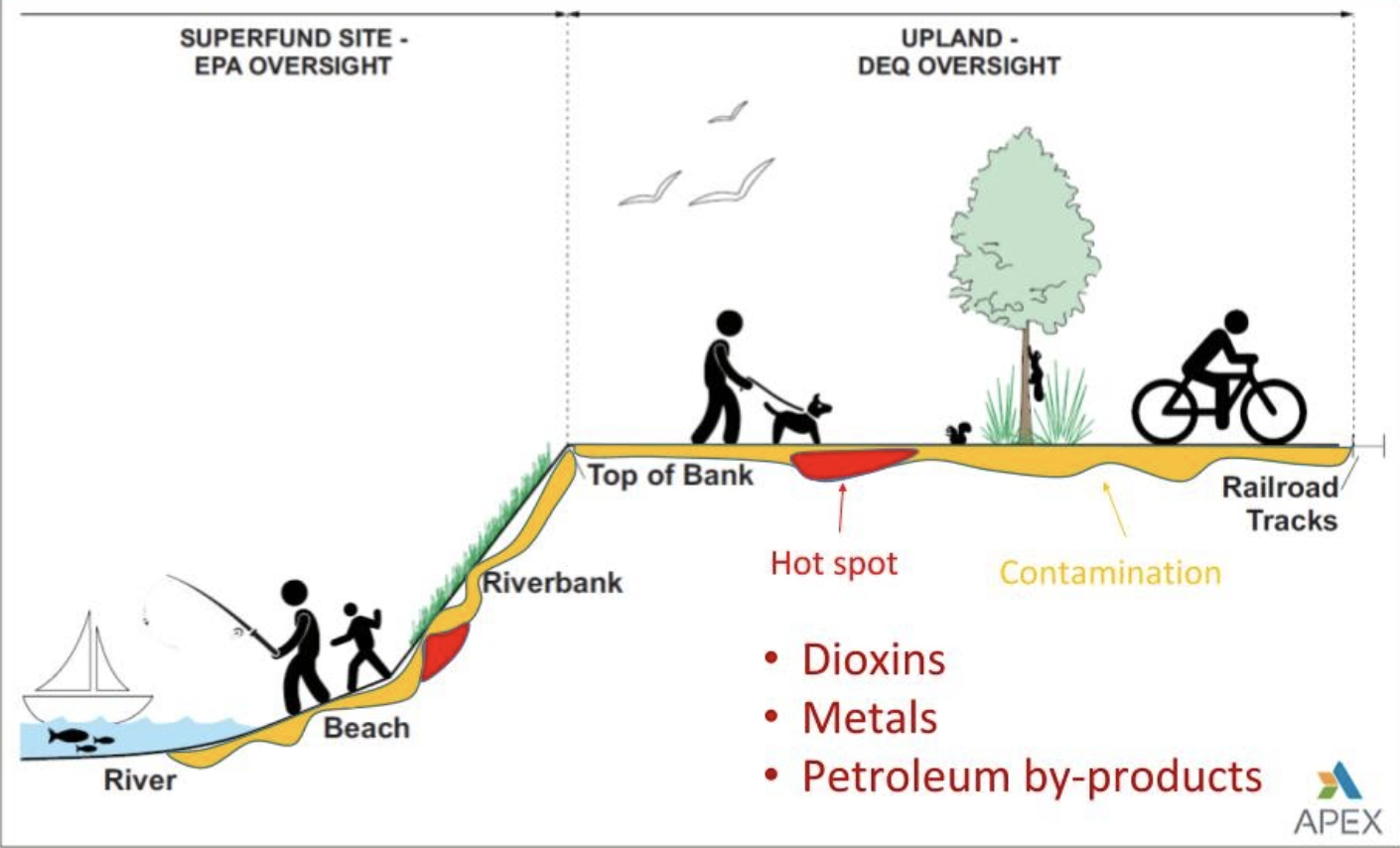
Willamette Cove is one of the only potential park spaces in North Portland along the Wilamut (Willamette River). Community members envision Willamette Cove as a potential place for low-impact activities like cultural ceremonies, hiking, canoeing, picnicking, kayaking, and exercising.
Victory at Willamette Cove!
In the summer of 2022, with tribal support, we successfully convinced Metro elected officials to pass a resolution for a comprehensive cleanup and restoration of 27 acres of land called Willamette Cove in North Portland that has tremendous cultural, historical, and natural significance. This is one step in the right direction toward healing the land, water, and people from decades of harm.
History & Background of Willamette Cove
Willamette Cove is near the railroad bridge and on the east bank of the Wilamut (Willamette River) in the St. Johns neighborhood, approximately in the middle of the Portland Harbor Superfund Site.
The site is bordered on the north by the Union Pacific Railroad and on the east by the Burlington Northern Railroad.
The site is about 27 acres with 3000 feet of riverbank.
Before the 1800s, approximately 3,000 Multnomah-Chinook people called the present-day Portland metropolitan area home, as they had for generations. Thousands of members of other bands and nations traveled through Wapato Valley for trading, fishing, and wapato-gathering. Willamette Cove may have been a village or other resting site.
Aerial view of Willamette Cove upland site
In the 1850s, the US government ratified treaties that eliminated access to resources and traditional homelands for Indigenous people and displaced them to reservations around the region.
The violent forced removal process and death by diseases brought by white settlers and colonizers opened space for white Euro-Americans to establish the Portland Harbor as a main hub for the exportation of grain, lumber, and other commodities, as well as a primary site of wartime shipbuilding (Goodling, 2020; Boyd, 1975, 2013; Ellis, 2013; Spores, 1993; Whaley, 2010).
Portland became home to the largest shipbuilding and ship-breaking operation in the US, with tens of thousands of workers, including 23,000 African Americans, thousands of Indigenous people and other communities from across the country, as well as Chinese migrant workers (Curry-Stevens, Cross-Hemmer, & CCC, 2011; Gibson, 2007).
Over the years, workers were exposed to extremely toxic substances on the docks, such as lead and asbestos. Black workers and their families, in particular, were also exposed to diesel emissions from harbor and freeway traffic in the nearby redlined Albina neighborhood. Previously, many Black people lived in Vanport, a multi-racial and segregated city built for shipyard workers at the north end of the harbor. Following the 1948 flood, some Black families were forced to relocate south to Albina, where the city and real estate industry began a systematic disinvestment process, that also led to part of the neighborhood being condemned for highway expansion.
Willamette Cove was acquired by the Metro regional government through public bond dollars with the intent of turning it into a City park in 1996. Metro claimed they were unaware of the extent of contamination at this particular site before they purchased it. The site has now been restricted from public access since Metro acquired the property.
Metro or its contractors routinely conduct sweeps of houseless residents and rest areas where houseless community members have tents, live in boats in the cove, and grow or gather food. Residents also use the site for recreation, swimming, walking, bird watching, bringing dogs, or canoeing.
Willamette Cove has become a focal point of interest for PHCC and others for many years. There are many concerns around how many people access the beautiful site, despite its extreme health risks.
Willamette Cove may appear to be inviting and picturesque, but remember that it was an industrial site a few decades ago.
Exposure to contaminants can occur throughout the entire site, from the beach to the furthest point away from the river. Toxins are still present in surface soil, which is the primary source of contamination at Willamette Cove
Contaminants present in the Willamette Cove In-Water and Upland areas
How are people exposed to contamination?
The largest exposure is because people incidentally ingest soil. Ingestion can occur from the following ways:
We track soil into our homes on our shoes
Pets track soil into our homes on their paws
Other exposure routes are soil contact on your skin and inhalation of contaminated dust
Chemicals can be toxic and cause health effects:
Effects can be acute or chronic. A large exposure over a short period (even once) can cause acute health effects, which result in immediate and often severe harm
Smaller exposures over a long period of time can cause chronic health effects, which can be long-lasting
Example – exposure to tobacco or asbestos over several years may result in lung cancer
It is unlikely that a person will experience acute health effects at Willamette Cove
Heavy metals can affect various body organs and can remain in the body for many years. Which organs are affected depends on the type of heavy metal:
Soil containing heavy metals are absorbed in the intestine into the blood.
Cadmium can build up in the kidneys and damage their ability to filter blood
Lead can build up in bones and affect the brain’s function, especially in children
Arsenic causes skin problems, immune dysfunction, and neurological problems
What are the health effects of the contamination?
Health effects of dioxins, which are widespread throughout Willamette Cove:
If you swallow soil containing dioxin, it can pass through your intestines into the blood.
Once in the body, it is found in the liver and body fat and can remain for up to 12 years.
Exposure to dioxin at Willamette Cove could result in a weakened immune system, changes in the liver, weight loss, changes to the body’s hormonal levels, and reproductive problems.









